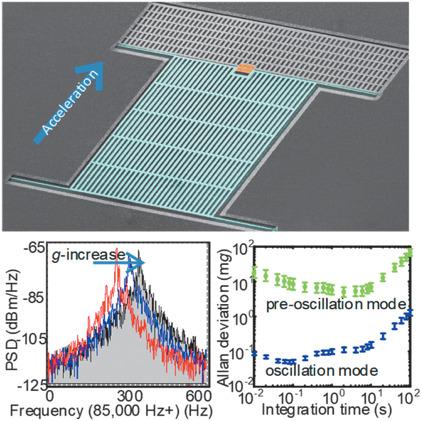当前位置:
X-MOL 学术
›
Laser Photonics Rev.
›
论文详情
Our official English website, www.x-mol.net, welcomes your
feedback! (Note: you will need to create a separate account there.)
A Chip‐Scale Oscillation‐Mode Optomechanical Inertial Sensor Near the Thermodynamical Limits
Laser & Photonics Reviews ( IF 9.8 ) Pub Date : 2020-04-08 , DOI: 10.1002/lpor.201800329 Yongjun Huang 1 , Jaime Gonzalo Flor Flores 2 , Ying Li 3 , Wenting Wang 2 , Di Wang 3 , Noam Goldberg 3 , Jiangjun Zheng 3 , Mingbin Yu 4 , Ming Lu 5 , Michael Kutzer 6 , Daniel Rogers 6 , Dim-Lee Kwong 4 , Layne Churchill 6 , Chee Wei Wong 2
Laser & Photonics Reviews ( IF 9.8 ) Pub Date : 2020-04-08 , DOI: 10.1002/lpor.201800329 Yongjun Huang 1 , Jaime Gonzalo Flor Flores 2 , Ying Li 3 , Wenting Wang 2 , Di Wang 3 , Noam Goldberg 3 , Jiangjun Zheng 3 , Mingbin Yu 4 , Ming Lu 5 , Michael Kutzer 6 , Daniel Rogers 6 , Dim-Lee Kwong 4 , Layne Churchill 6 , Chee Wei Wong 2
Affiliation

|
Modern navigation systems integrate the global positioning system (GPS) with an inertial navigation system (INS), which complement each other for correct attitude and velocity determination. The core of the INS integrates accelerometers and gyroscopes used to measure forces and angular rate in the vehicular inertial reference frame. With the help of gyroscopes and by integrating the acceleration to compute velocity and distance, precision and compact accelerometers with sufficient accuracy can provide small‐error location determination. Solid‐state implementations, through coherent readout, can provide a platform for high performance acceleration detection. In contrast to prior accelerometers using piezoelectric or capacitive readout techniques, optical readout provides narrow‐linewidth high‐sensitivity laser detection along with low‐noise resonant optomechanical transduction near the thermodynamical limits. Here an optomechanical inertial sensor with an 8.2 µg Hz−1/2 velocity random walk (VRW) at an acquisition rate of 100 Hz and 50.9 µg bias instability is demonstrated, suitable for applications, such as, inertial navigation, inclination sensing, platform stabilization, and/or wearable device motion detection. Driven into optomechanical sustained‐oscillation, the slot photonic crystal cavity provides radio‐frequency readout of the optically‐driven transduction with an enhanced 625 µg Hz−1 sensitivity. Measuring the optomechanically‐stiffened oscillation shift, instead of the optical transmission shift, provides a 220× VRW enhancement over pre‐oscillation mode detection.
中文翻译:

接近热力学极限的芯片级振荡模式光机械惯性传感器
现代导航系统将全球定位系统 (GPS) 与惯性导航系统 (INS) 集成在一起,两者相辅相成,可以确定正确的姿态和速度。INS 的核心集成了加速度计和陀螺仪,用于测量车辆惯性参考系中的力和角速率。借助陀螺仪并通过集成加速度来计算速度和距离,具有足够精度的精密紧凑的加速度计可以提供小误差位置确定。通过相干读出,固态实现可以提供高性能加速度检测的平台。与之前使用压电或电容读出技术的加速度计相比,光学读出提供窄线宽高灵敏度激光检测以及接近热力学极限的低噪声谐振光机械转换。这里展示了一种光机械惯性传感器,其采集速率为 100 Hz,偏置不稳定性为 50.9 µg,具有 8.2 µg Hz −1/2速度随机游走 (VRW),适用于惯性导航、倾斜传感、平台稳定等应用和/或可穿戴设备运动检测。在光机械持续振荡的驱动下,狭缝光子晶体腔以增强的 625 µg Hz -1灵敏度提供光驱动换能的射频读数。测量光机械强化振荡位移(而不是光传输位移)可比预振荡模式检测提供 220 倍 VRW 增强。
更新日期:2020-04-08
中文翻译:

接近热力学极限的芯片级振荡模式光机械惯性传感器
现代导航系统将全球定位系统 (GPS) 与惯性导航系统 (INS) 集成在一起,两者相辅相成,可以确定正确的姿态和速度。INS 的核心集成了加速度计和陀螺仪,用于测量车辆惯性参考系中的力和角速率。借助陀螺仪并通过集成加速度来计算速度和距离,具有足够精度的精密紧凑的加速度计可以提供小误差位置确定。通过相干读出,固态实现可以提供高性能加速度检测的平台。与之前使用压电或电容读出技术的加速度计相比,光学读出提供窄线宽高灵敏度激光检测以及接近热力学极限的低噪声谐振光机械转换。这里展示了一种光机械惯性传感器,其采集速率为 100 Hz,偏置不稳定性为 50.9 µg,具有 8.2 µg Hz −1/2速度随机游走 (VRW),适用于惯性导航、倾斜传感、平台稳定等应用和/或可穿戴设备运动检测。在光机械持续振荡的驱动下,狭缝光子晶体腔以增强的 625 µg Hz -1灵敏度提供光驱动换能的射频读数。测量光机械强化振荡位移(而不是光传输位移)可比预振荡模式检测提供 220 倍 VRW 增强。











































 京公网安备 11010802027423号
京公网安备 11010802027423号